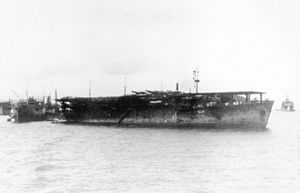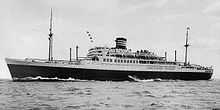Japanese aircraft carrier Chūyō
 Chūyō | |
| Career (Japan) | |
|---|---|
| Name: | Nitta Maru |
| Operator: | Nippon Yusen (NYK) |
| Builder: | Mitsubishi Shipbuilding & Engineering Co. Nagasaki, Japan |
| Yard number: | 750 |
| Laid down: | 9 May 1938 |
| Launched: | 20 May 1939 |
| Completed: | 23 March 1940 |
| In service: | 1940 |
| Out of service: | 1942 |
| Fate: | converted to military use, renamed as Chūyō |
| Career (Japan) | |
| Name: | Chūyō |
| Commissioned: | 25 November 1942 |
| Fate: | Sunk by the submarine USS Sailfish, 4 December 1943 |
| General characteristics | |
| Class and type: | Taiyō-class escort carrier |
| Displacement: | 17,830 long tons (18,120 t) (standard) 19,500 long tons (19,800 t) (full load) |
| Length: | 173.7 m (569 ft 11 in) (w/l) 180.4 m (591 ft 10 in) (o/a) |
| Beam: | 22.5 m (73 ft 10 in) |
| Draft: | 7.74 m (25 ft 5 in) |
| Installed power: | 25,200 shp (18,800 kW) |
| Propulsion: | 2 × Kampon geared steam turbines 4 × Kampon water-tube boilers 2 × shafts |
| Speed: | 21 kn (39 km/h; 24 mph) |
| Range: | 6,500 nmi (12,000 km; 7,500 mi) at 18 kn (33 km/h; 21 mph) |
| Complement: | 850 |
| Armament: | Upon completion as escort carrier: 8 × 127 mm (5 in) L/40 Type 89 anti-aircraft guns (4x2) 30 × 25 mm (0.98 in) L/60 Type 96 anti-aircraft cannons |
| Armor: | 2.5 cm (0.98 in) side belt over machinery spaces and magazines |
| Aircraft carried: | 27 |
Chūyō was a Taiyō-class escort carrier operated by the Imperial Japanese Navy in World War II. Originally built as the passenger liner Nitta Maru, it was converted to military use in 1942.
Civilian service

The Nitta Maru (新田丸) was a Japanese ocean liner owned by Nippon Yusen Kaisha. The ship was built in 1938-1940 by Mitsubishi Shipbuilding & Engineering Co. at Nagasaki, Japan. It was laid down in May 1938 and launched on 20 May 1939. She left port on 23 March 1940 on her maiden voyage.[1] The 17,163-ton vessel had a length of 560 feet (170 m), and her beam was 74 feet (22.5 m). The ship had an average speed of 19-knots.[1] The vessel's pre-war design anticipated passenger service; but when work was completed, the onset of war had created somewhat different priorities.
The vessel was created as a sister ship of the Yawata Maru, and the Kasuga Maru. None of the three survived the Second World War. Each in succession was re-fitted as a troopship; and each was later converted to an aircraft carrier. In 1941, Kasuga Maru was re-commissioned as the Japanese aircraft carrier Taiyō and in 1942, the Yawata Maru was recommissioned as the Japanese aircraft carrier Unyō.[2]
In November 1942, the Nitta Maru was recommissioned as the Japanese aircraft carrier Chūyō.[2]
When first launched, this ship was named after an important Shinto shrine.[3]
Military service
The ship was requisitioned for use as a military transport in February 1941. She made a few voyages, including a number for transferring of American Prisoners of War (POWs) from Wake Island to Japan.
The first transfer of POWs departed Wake Island on 12 January 1942, arriving in Yokohama on or around 20 January. After departing Yokohama, the Japanese took five men topside, and to "honor their bravery," tortured and beheaded them. The bodies were mutilated with bayonets and thrown overboard.[4]
After the Battle of Midway, it was decided to convert her to an escort carrier. The conversion took place in Kure between 20 August and 25 November 1942. She was renamed Chūyō (冲鷹, "Hawk which soars").
Her flight deck measured 150 m × 23 m (492 ft × 75 ft) and was equipped with two elevators. She had no island or catapults; whether she carried arresting gear is a matter of some dispute. The Chuyo and her sisters have been described as not so equipped, but many experts dispute that they lacked arresting gear, and while photographic evidence is lacking, the Chuyo during her service life operated aircraft that required arresting gear to land aboard a carrier.
Operational history
Chūyō was used primarily for flight training and aircraft transport. She often sailed with her sister ships Taiyō and Unyō.
On 4 December 1943, Chūyō and Unyō were sailing from Truk to Yokosuka—carrying prisoners the Japanese took from the American submarine USS Sculpin—when Chūyō was hit by a torpedo fired by USS Sailfish at 32°37′N 143°39′E / 32.617°N 143.650°E, close to the island of Hachijōjima. During the next few hours, Sailfish attacked the damaged carrier two more times. After taking four of the five torpedoes the submarine had fired at her, Chūyō sank quickly, taking about 1250 people with her; 20 of the 21 prisoners she was carrying were among them. She was stricken from the naval list in 1944.
See also
- List by death toll of ships sunk by submarines
Notes
- ↑ 1.0 1.1 Haworth, R.B. Miramar Ship Index: ID #4046813.
- ↑ 2.0 2.1 CombinedFleet: Taiyō class, Imperial Japanese Navy.
- ↑ Ponsonby-Fane, Richard. (1935). The Nomeclature of the N.Y.K. Fleet, p. 50.
- ↑ Wake Island POWs at Zentsuji (Accessed 9 June 2007)
References
- Dr. Bak József et al. (1984): Hadihajók. Típuskönyv. Zrínyi Katonai Kiadó. ISBN 963-326-326-3
- Ponsonby-Fane, Richard Arthur Brabazon. (1935). The Nomeclature of the N.Y.K. Fleet. Tokyo : Nippon Yusen Kaisha. OCLC 27933596
- Tate, E. Mowbray. (1986). Transpacific steam: the story of steam navigation from the Pacific Coast of North America to the Far East and the Antipodes, 1867-1941. New York: Cornwall Books. 10-ISBN 0-8453-4792-6; 13-ISBN 978-0-8453-4792-8; OCLC 12370774
External links
- Imperial Japanese Navy Page
- Carriers of World War II
- Taiyo Class
- Naval Weapons of the World
- Warship.get.pl
- Japanese "Maru" Ships
- IJN Chuyo: Tabular Record of Movement
| ||||||||||